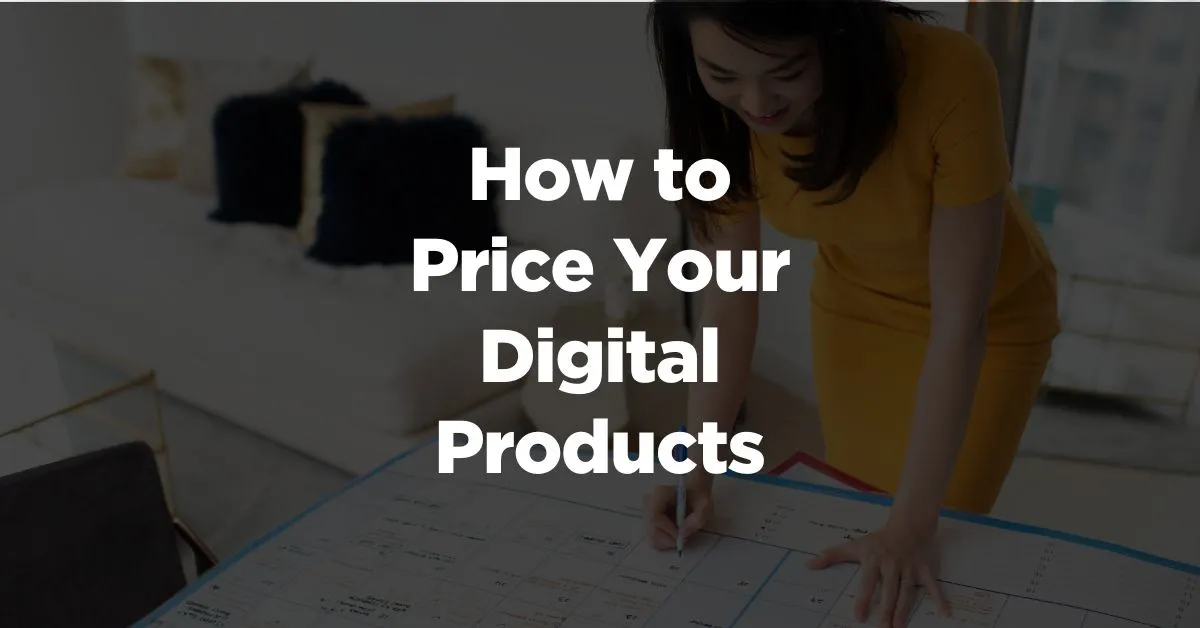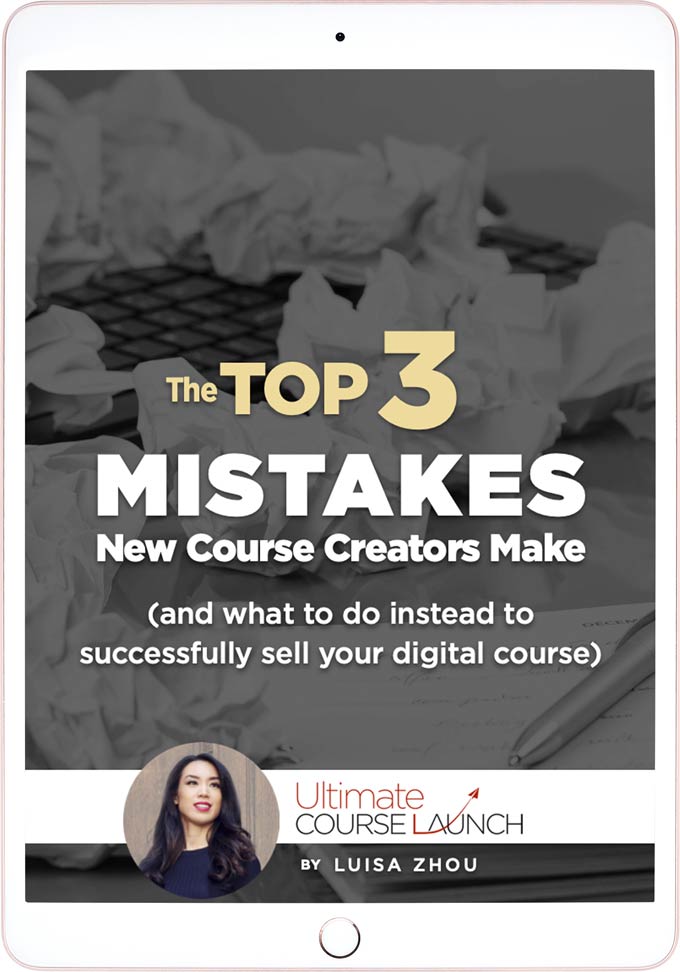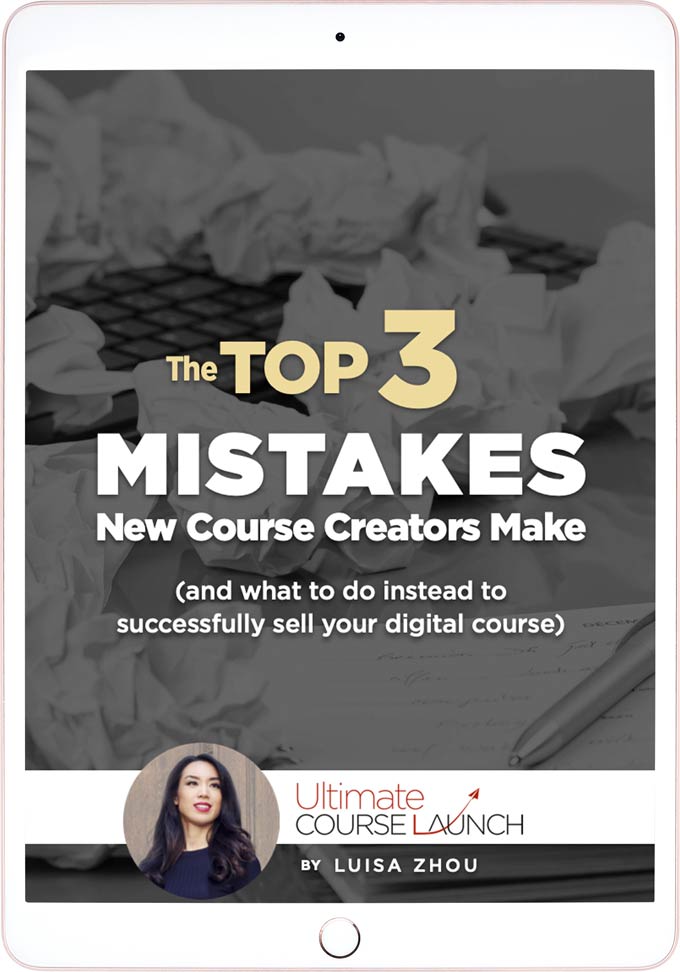Want to know how to price your digital products?
You’re in the right place.
I’ll share the best models for digital product pricing, plus a step-by-step guide on how to set the right price for your digital product (including ebooks, online courses, templates, and more).
Ready to get started? Let’s dive right in.
Discover the top 3 reasons most courses fail
(plus how to fix them so you succeed)
The best pricing model for digital products
Digital products can be highly profitable, with the industry expected to make over $200 billion in the next few years. But to make your business successful, the price has got to be right.
Here’s a quick overview of how digital product pricing normally works:
- A mini online course with 4-10 training videos sells for around $47 to $147, with the average price being $137.
- Longer (flagship) online courses with videos, photos, audio, and PDF extras tend to sell for between $1,000 and $3,000.
- Informational ebook prices range from $7 to $27 depending on the subject and length.
- Software templates (like Canva or Notion templates) can be sold for anything between $5 and $50.
- If you’re selling a mobile app, the most popular pricing models are freemium or subscription. Subscriptions sell for around $0.99 to $9.99 per month.
- Digital art has a wide range of price points, depending on your reputation as a creator. But most artwork falls between $5 and $250.
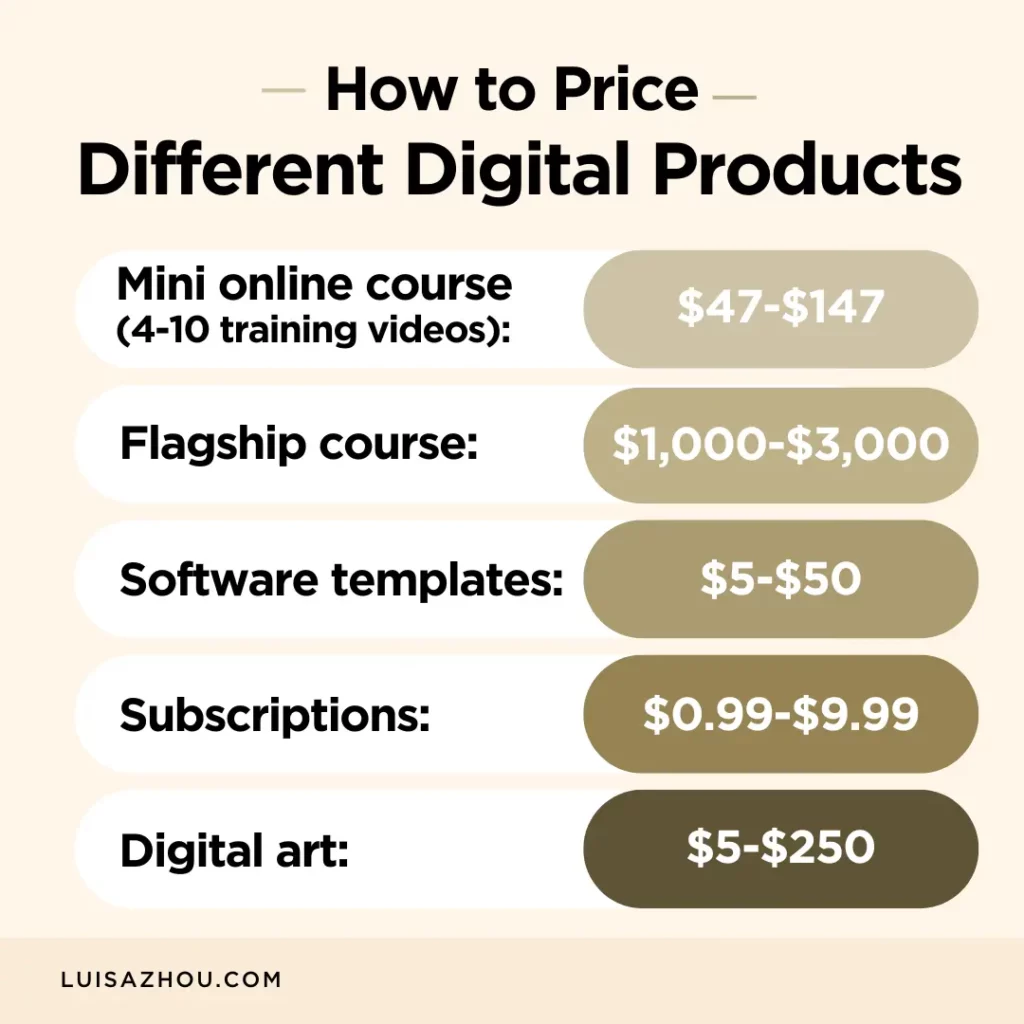
But remember: These numbers are just averages. I’ve sold online courses and trainings at multiple different price points.
Why?
Because it all depends on the value of the product.
By the end of this guide, you’ll know exactly how to figure out the value of your products.
Later on, we’ll go through digital product pricing strategies in detail.
But for now, let’s define what a “digital product” actually is.
What are digital products?
Digital products are intangible products you sell online.
For example:
- Online courses
- Ebooks
- Apps
- Digital art
- Stock photos/videos
- Software templates
Because these are online assets with no raw materials, storage, or shipping costs, digital pricing models are completely different from physical products.
So how do you go about pricing digital products? We’ll talk about that next.
Top pricing models
The most popular pricing models for digital products are:
- One-off pricing
- Subscriptions
- Freemium
- Upsells
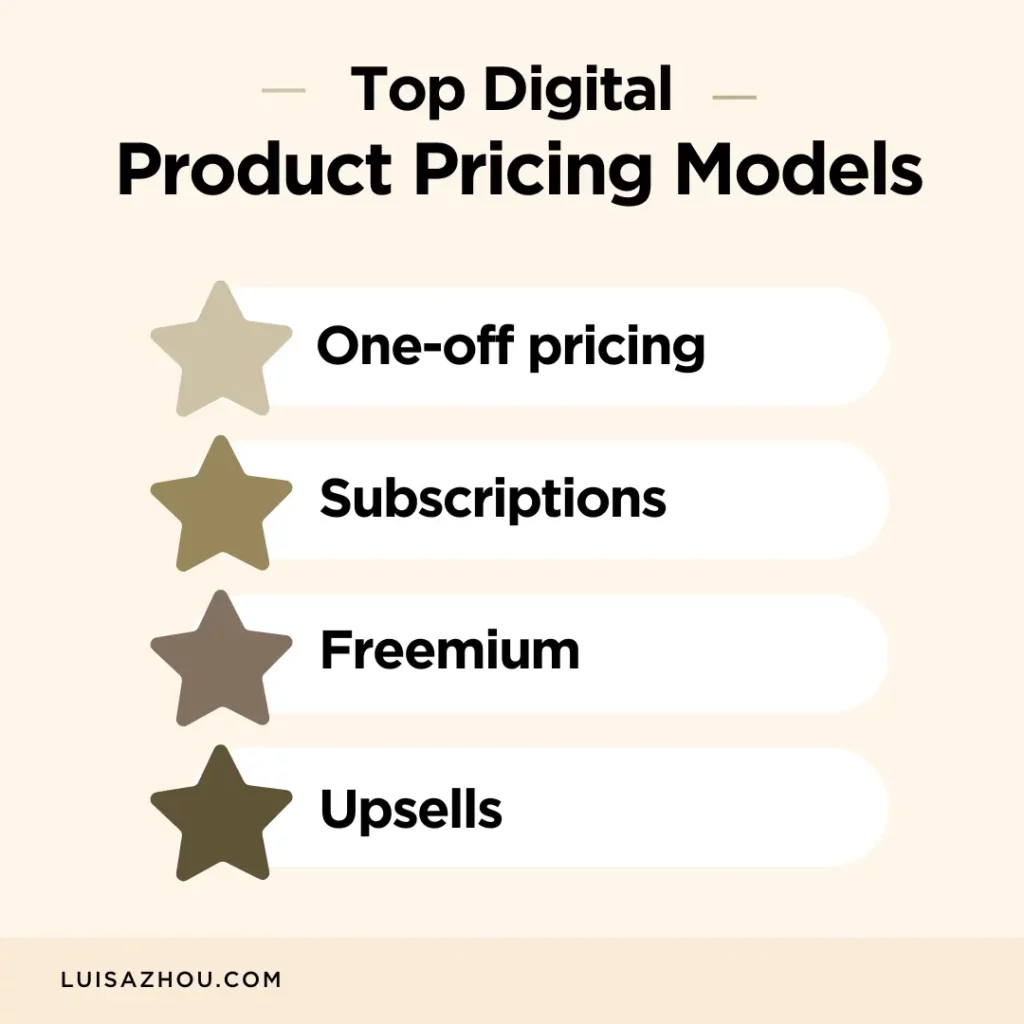
Let’s look at each in a little more detail.
One-off pricing
One-off pricing is my favorite way to price my digital products.
Why?
Because not only does it work well for every type of digital product, but this type of pricing is also easier to market to your audience.
I’ve sold all my online courses at competitive one-off prices, and that’s how I made my first million dollars.
Here’s how I made $8K with my first course launch using one-off pricing:
Subscriptions
Subscriptions are another pricing model.
Subscriptions offer a predictable income every month – which can result in more revenue in the long run.
But here’s the thing:
The average American already spends $38 to $200 a month on subscriptions, and people are growing tired of it.
It’s even got a name – subscription fatigue.
Because of this, you’ve got to work even harder to keep people subscribed to your product.
And that’s why I prefer to charge a one-off premium price for my products.
Discover the top 3 reasons most courses fail
(plus how to fix them so you succeed)
Freemium
Freemium is when you have a free version of a product, but your customers can upgrade to the full experience for a one-off price or subscription.
This works well for some digital products but not others.
For example, a freemium online course probably wouldn’t go down well with customers (more on that in my guide to pricing courses).
But freemium memberships, software, and apps can work great.
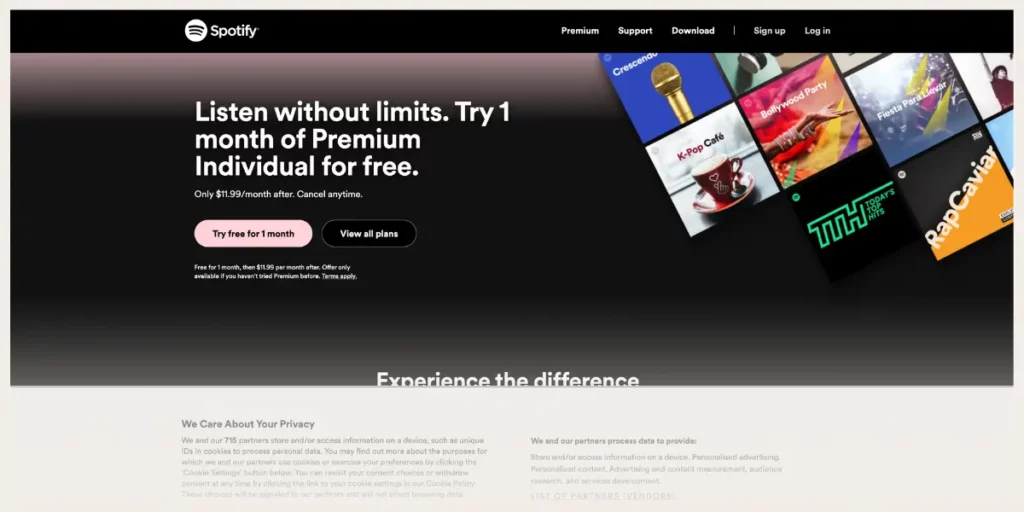
Upsells
An upsell is an additional product or feature your customers can purchase with the main product.
For example, you could sell an online course and offer a coaching session as an add-on.
Bundles are another way of raising the value of your products, but we’ll talk more about that later.
For now, what strategy should you use to price your product? Read on to learn more.
Top digital product pricing strategies
At this point, you might have an idea of the kind of pricing model that could work for your digital product. But how can you know for sure?
Well, good news: There are three ways you can figure out your pricing.
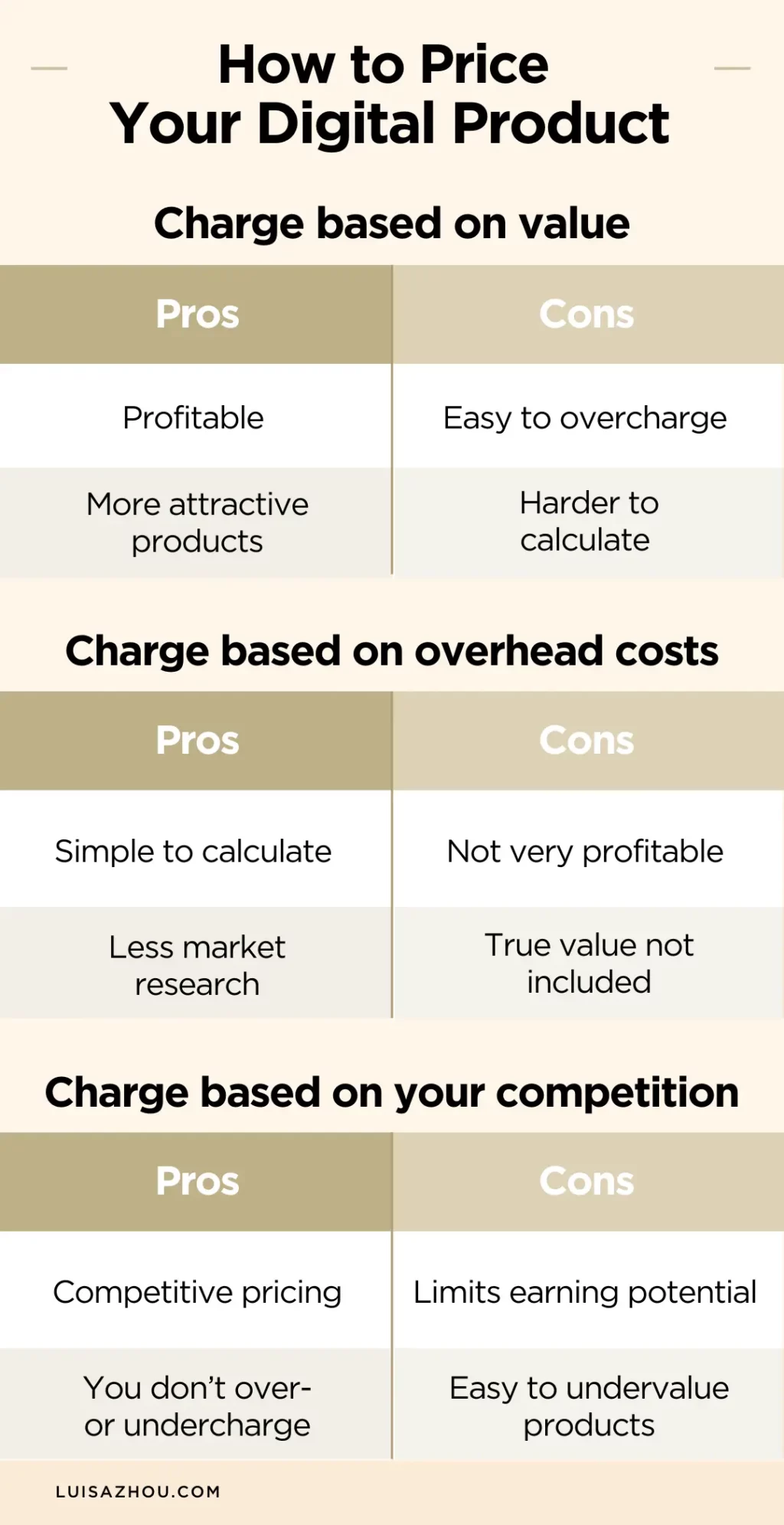
(Spoiler: The first strategy is the best.)
Charge based on value, not price
Value-based pricing is when you consider the results of your product and set a price from there.
For example:
My flagship course, Employee to Entrepreneur (ETE), teaches people how to create six-figure businesses and quit their corporate jobs.

And because so many of my students have said that the course is super high value, it means I can charge a high ticket price.
Now I’ll admit, it’s tough to figure out the value of your work in the beginning.
But ask yourself:
- How much money would someone save or gain by using your product?
- Does your product save someone time?
- What’s the aesthetic or entertainment value of your product?
And if you’re not sure, ask your audience for feedback.
Pros
- More profitable than other strategies
- Higher pricing can make your products more attractive
Cons
- It’s easier to overcharge
- Can be harder to calculate than other strategies
Discover the top 3 reasons most courses fail
(plus how to fix them so you succeed)
Charge based on your overhead costs
If your digital product has clear production costs, you can set a price to cover those costs.
To do this, you need to know exactly how much it costs to create your product (including the price of software subscriptions, freelancers, and so on).
This is the simplest way to calculate your prices. But simple doesn’t always mean better.
For one, it doesn’t take into account the true value of the product.
Take my friend Susie Moore for example. Her Five Minutes To Famous course has helped people get high-profile media features in global publications.

And that kind of exposure without a publicist is really valuable!
Another thing to consider is your business costs. This strategy only focuses on production and overhead, but what about taxes and time? That’s why charging by overheads typically results in undercharging.
Pros
- Simple to calculate
- Requires less market research
Cons
- Not very profitable
- Doesn’t take into account the true value of the product
Charge based on your competition
The final way to choose your digital product pricing is to look around.
By that I mean research your competitors and price yourself around that range.
Should you ever compare yourself to your competition?
Yes and no.
Your audience will be comparing your products to similar ones on the market. So you don’t want to be priced too high or you could turn customers away.
Here are my thoughts on competition:
At the same time, your business, brand, and digital products are unique.
Maybe your products should be priced higher because they provide more value than your competitors.
Pros
- Makes your prices comparable to competitors
- Ensures you don’t overcharge or undercharge
Cons
- Limits your earning potential
- Easy to undervalue your own products that stand out from competitors
How to price your digital products
Now, let’s dive into the steps to figure out the best price for your products.
They are:
- Focus on value rather than price
- Understand your target audience
- Research your competitors
- Take your experience and digital product features into account
- Calculate your overhead
- Increase the value of your offer
These steps apply to any digital product, from stock photography to mobile apps. However, I’ll be using examples of online courses because they’re highly profitable and simple to create.
Sound good? Then keep reading!
1. Focus on value rather than price
Question: What do people get out of using your digital product?
Because the real value of your product is not the fancy branding or materials.
It’s the transformation you offer – more specifically, it’s the transformation that aligns with your customer’s end goal.
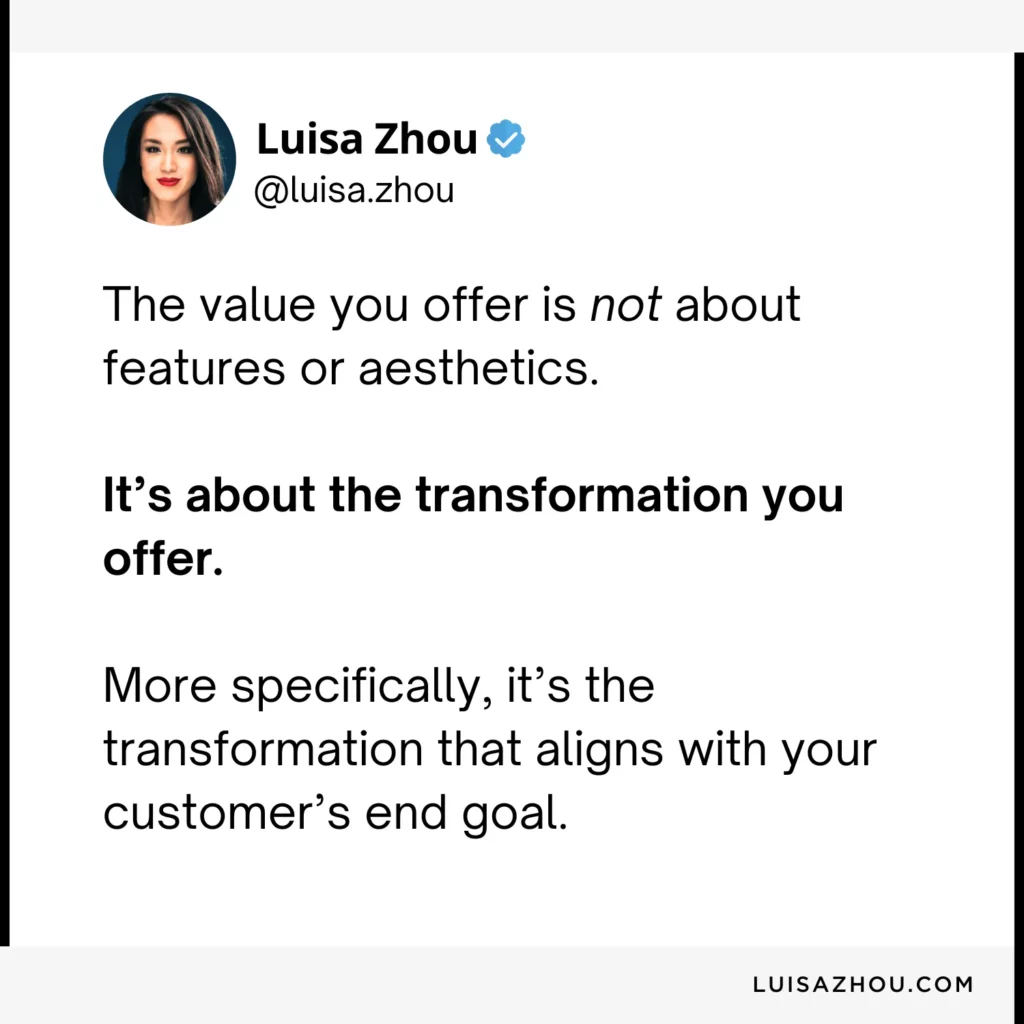
For example, my target audience is people who want to quit their jobs and work for themselves.
So I created a course that I wish I had when I was starting my business (Employee to Entrepreneur). That way, I can pitch my product as a solution to their problem – figuring out how to build a business from scratch.
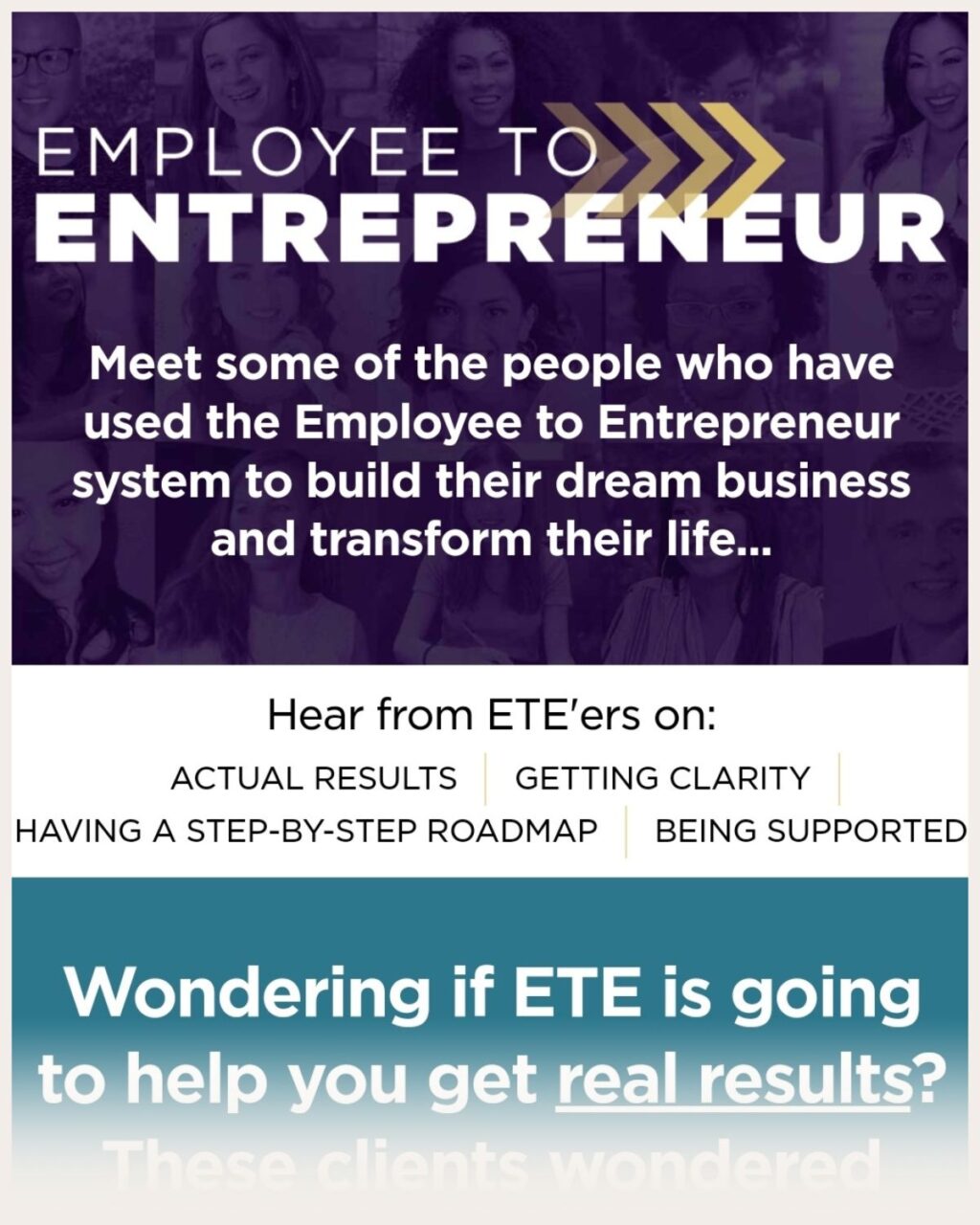
Now, you can measure transformation in different ways.
Ask yourself:
How will my customer’s life be different after using my digital product?
Will they feel different? Look different? Act different?
And once you understand the result your product offers, how do you figure out what your audience will pay for it? That’s what we’ll talk about next.
2. Understand your target audience
Can you get pricing wrong?
Yes, you can.
The most common mistake I see is not understanding your target audience. After all, your audience is the defining factor in pricing.
In short, what are they willing to pay for a product like yours?
For example, if you’ve created a meal plan ebook for college students, it needs to be cheaper than an ebook aimed at top executives (because one has way more disposable income than the other).
So how do you figure this out for your audience?
You could:
- Ask them: Reach out to some ideal customers and ask for their opinion. This works well if you already have a social media following. You can direct message customers for quality market research.
- Create an ideal customer profile: This is a game-changer in helping you understand the type of person you’re targeting. My customer avatar is a woman in her early thirties who is unsatisfied with her corporate job and wants to start a business.
- Research your competitors with similar audiences: If other digital product sellers in your niche are finding success at a certain price point, it’s likely you will too. But more on that in the next chapter.
This video will give you more strategies to figure out the pricing sweet spot:
Tip: Don’t let your friends and family sway you when it comes to pricing.
Coming from an immigrant family, my parents thought asking for more money is a “scam.”
But they are not my target audience! Believe in yourself and your product enough to charge what it’s really worth to your ideal customers.
Now, let’s look at the competition.
Discover the top 3 reasons most courses fail
(plus how to fix them so you succeed)
3. Research your competitors
Earlier, we talked about competitor-based pricing as a strategy. And, I think we can agree it has some flaws.
After all, you don’t want your income potential to be limited by your competition, do you?
But does that mean you should ignore your competition altogether?
No. I recommend a more well-rounded approach to your digital product pricing.
Plus, looking at your competitor’s products and pricing will give you a good idea of what people are already willing to pay.
Of course, there’s another side to competitor analysis. If you’re anything like me, you want your products to be the best, right?
Well, for your products to be top quality, you need to know what’s already on the market.
That way, you’ll be able to think about how you can offer something more detailed, comprehensive, or organized.
Take ETE for example:
I designed a clear step-by-step path for corporate employees to help them create successful businesses. Something that wasn’t on the market at the time.
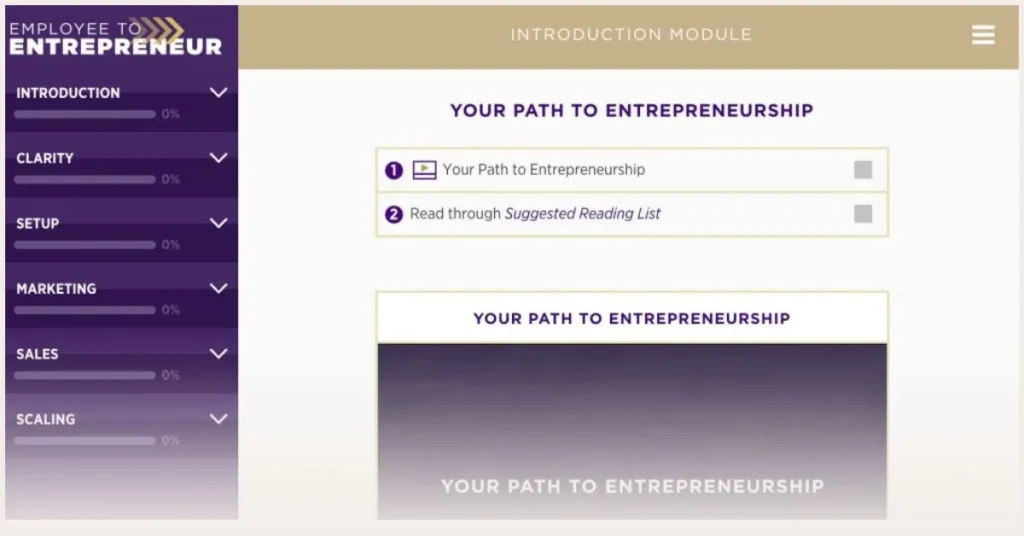
Just 10% better than your competition means you can charge a higher price for your products than the going rate.
In other words:
Making your products stand out = more money in the bank.
Other factors that impact your pricing include your credentials, experience, and product features.
Read on for more on that.
4. Take your experience and digital product features into account
Look: Your experience is valuable.
If you’ve been a nutritionist for 20 years and decide to create a meal planning ebook, it’s going to be more valuable than an ebook from the average person.
But it’s not just years or credentials that count.
For example:
Take my student Emily Liou from Cultivitae. She was a recruiter for top Fortune 500 companies, which gave her priceless inside knowledge on which candidates get jobs and which don’t.
Then, she distilled her knowledge into an easy-to-follow program.

So think about the value of your experience and background.
And remember: Your digital product’s features can also increase the value.
For instance, a self-study 6-week course is less valuable than a 6-month live course.
And it’s not just length that matters. Consider:
- What is the format of your digital product? Video products – especially courses – tend to be of higher value than text and photos alone. You could add a video element to your product to make it more informative and appealing to your audience. For example, if you create a Canva template, include a video tutorial on how to download and use it.
- Is your digital product unique? Maybe you have a special way of organizing fitness programs, so your PDF stands out from your competition. Or perhaps as a digital artist, you’re only selling a particular art piece to one person. In short, scarcity raises the value.
- What support are you willing to offer your customers? Digital products are pretty hands-off. However, the support you offer significantly increases the value of anything you sell. As a course creator, I made myself available for questions and feedback to help my students achieve their goals.
- How comprehensive is the information? If you’re selling a course, ebook, template, or PDF, listen up. A more comprehensive product is a more valuable product. But avoid adding too much information – your audience doesn’t want any irrelevant fluff.
In this video, I talk about how a more streamlined product can make you more sales. (Spoiler: Because it’s focusing on what your customers really need!):
5. Calculate your overhead
Ask yourself: How much would you need to charge to make a profit?
Overheads can be difficult to calculate for digital products, so let’s break it down.
First, what do you need to create your product?
Think software costs (like Teachable or Kajabi), platform hosting, and outsourcing.
Even your internet connection goes into your overhead costs – you can’t make the product without it!
Your next major cost is marketing.
Some of my students invest in paid ads to sell their online courses – and with good reason.
Marketing expert Rick Mulready tells us why Facebook ads make $2 for every $1 spent and how it can work for you:
However, if you don’t want to spend on ads, you don’t have to. In fact, there are a ton of ways to market your digital product without ads including:
- Finding influencers in your niche to promote your product
- Posting consistently on social media
- Growing your SEO
That said, even if you don’t use paid ads, you still need a marketing budget. For example, you could invest in a social media scheduler like Later to automate posting on your chosen platforms.
Calculate those costs and you can figure out your profit margin.
To do that, you need to know the number of leads you generate from marketing and the amount of actual sales you get.
If this is your first product, use a conservative estimate for leads and 1% sales conversion rate.
Now here’s an important thing you need to know about digital product pricing:
The price you set is just the beginning. By increasing the value of your offer, you can make more per sale.
Sound good? Keep reading.
Discover the top 3 reasons most courses fail
(plus how to fix them so you succeed)
6. Increase the value of your offer
So far, we’ve talked about how to set a fair price for your digital product, no matter what it is.
But the truth is, some digital products are easier to price at a premium than others.
That’s what makes online courses so profitable: You can charge high ticket prices for quality, comprehensive courses.
What if you’ve created a template or simple 5-page PDF? Those typically sell for $5 each. Can you ask for more?
You can by adding more value.
How? Here’s what I did.
My first course was a short self-study course that I sold for $497. This led to my first $8K course launch.
To increase the value, I called my students after they’d completed the course and asked for feedback.
Many said they enjoyed the course but wanted more help getting clients.
That’s where I saw an opportunity to upsell. No salesy tactics, just a simple offer for a 1-on-1 or a more comprehensive course.
And guess what?
I made another $20,000.
Beyond making more money on your launches, why should you upsell?
By upselling, you:
- Grow faster as a business
- Increase your profits
- Provide more value to your audience
- Attract the right customers
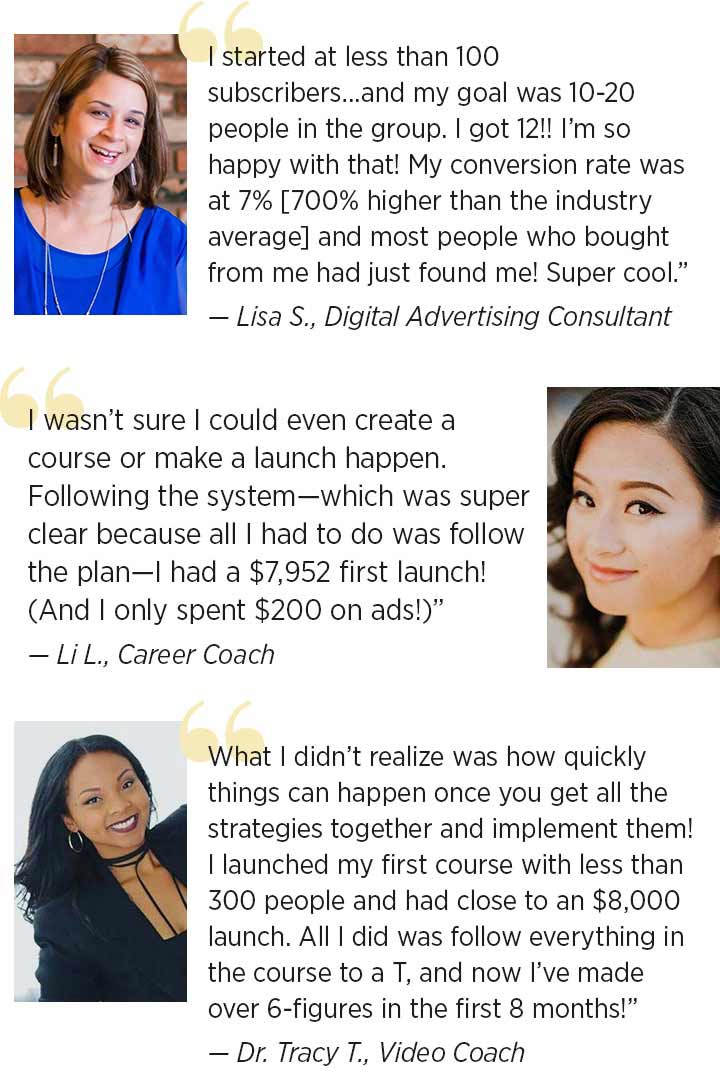
So how can you upsell your product? Here are some ideas:
- Create a bundle: Got other products that could help your customers achieve their ultimate goal? Bundle them into a single package at a discounted rate. That way, your customers get more value for money and you make more on a single sale.
- Add a one-on-one session: Whether it’s a coaching session, a done-for-you service, or consulting, you can help people even more by giving them some of your time.
Offer a payment plan: If you’re selling a high-ticket course, why not break it down into more affordable payment plans? You can also charge a little more for payment plans, which increases the value of your product.
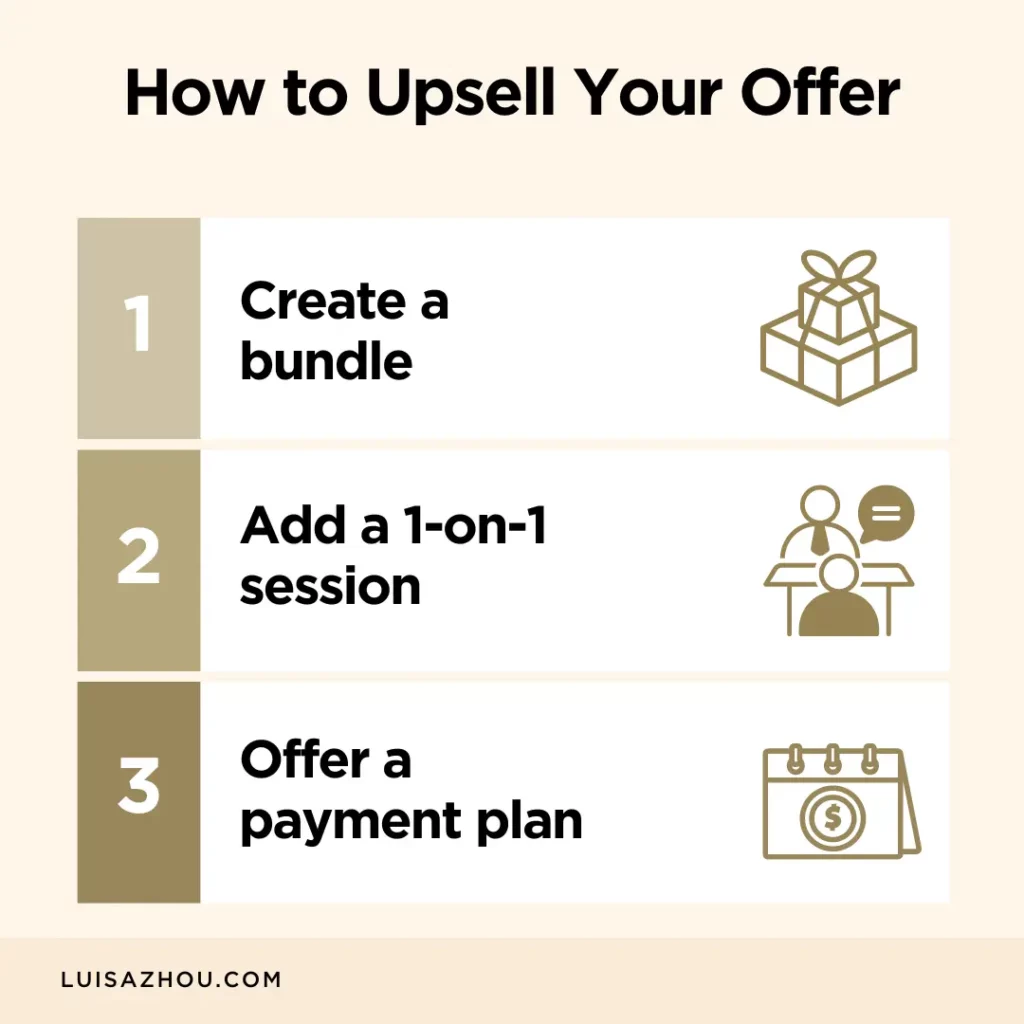
What’s next?
And that’s it! Your ultimate guide to digital product pricing.
The thing is:
A digital product business can be highly lucrative, but the most profitable type of digital product is an online course.
They are flexible, simple to make, and generate a lot of revenue.
However, I’ve worked with thousands of course creators and seen people make the same mistakes again and again.
Specifically, three big mistakes hold new course creators back.
Want to know what they are?
Get my free PDF so you can avoid these mistakes and create a highly profitable course the first time.
Read more:
The Most Profitable Digital Products To Sell
How to Promote Digital Products
How to Create an Online Course
